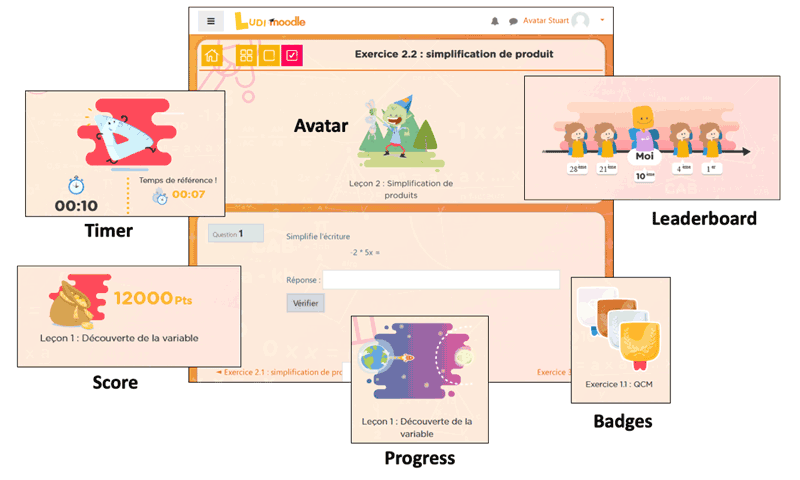by Élise Lavoué (Université Jean Moulin Lyon 3)
The LudiMoodle project aims to adapt game elements integrated into the Moodle learning environment to help motivate learners.
The gamification field has been growing over the last decade. Most studies that have investigated the use of gamification in education have highlighted its benefits in terms of learner performance and motivation. However, these studies have generally focused on short-term effects, and do not differentiate between the impact of each game element according to the context or the learner profile. More recent studies, considering the impact of each game element separately, have shown that their impact depends on the learner profile [1] (e.g., motivation, player type, personality traits), with some game mechanisms being detrimental to specific learners [2]. For instance, in a previous study, we showed that amongst the most engaged learners (i.e., learners who use the environment the longest), those with adapted game elements spend significantly more time in the learning environment [3].
In this context, the LudiMoodle [L1] project aims to acquire new insights into the impacts of specific game elements, including: timer; leaderboard; progress; avatar; badges and scores, on learner motivation when using a digital learning environment (Figure 1). The project will provide (i) researchers with a model for the adaptation of game elements to the learner profile; (ii) instructional designers with a generic plugin to gamify resources offered in the Moodle learning environment; and (iii) teachers with recommendations to gamify their courses in a way that motivates learners with different profiles and motivation.

Figure 1: Game elements developed within the LudiMoodle project for the Moodle learning platform.
The project is led by the University of Lyon [L2]. It involves the education authority (Rectorat) of Lyon [L3], researchers both in computer sciences (LIRIS lab [L4]) and educational sciences (ECP lab [L5]), instructional designers from the University Lyon 3 [L6] for the design of digital learning resources in close collaboration with teachers, as well as the Edunao [L7] company dedicated to the development of the game elements. Ground experiments are conducted in middle schools of the Lyon Educational District. Teachers are involved in the design of game elements during participatory design sessions to create meaningful and motivating game elements.
The four-year project began in January 2017. We ran a first experiment in March-April 2019 over ten course sessions that involved 258 fourth grade pupils in four middle-schools, in a mathematics course. Learners used individual tablets that displayed exercises and they were guided in the digital environment. The six game elements were randomly assigned to learners, one game element per learner, to answer two research questions: (i) How does gamification influence learner motivation? And (ii) Which factors influence the impact of game elements on learner motivation? We used questionnaires to assess the initial level of motivation of the learners before the course and the level of motivation at the end of the course. We also asked learners to fulfill the Hexad [L8] questionnaire to identify their player type. Finally, we collected all interaction traces with the learning environment to identify their performance (correct and incorrect answers) and engaged behaviours (e.g., number of exercises, time spent on an exercise, time spent to answer a question).
The first results show that learners’ intrinsic and extrinsic motivation decreased during the experiment. These results are not surprising since game elements were randomly distributed amongst learners and may not fit their motivation for the course and preferences for game mechanisms. We also observed an increase in learner motivation in the students that were least motivated initially. A deeper analysis showed that two factors influenced the impact of game elements on learner motivation and performance: (i) the initial level of motivation at the beginning of the course and (ii) the player profile, achiever and player dimensions being the most important. An analysis per game element also showed that (i) each game element influences different dimensions of motivation (either intrinsic, extrinsic or amotivation); and (ii) the impact of each game element depends on a different combination of factors including the initial motivation and certain dimensions of the player profile.
A second experiment is planned for March-April 2020 to identify the impact of adaptive gamification on learner motivation. An adaptation engine will be integrated into the digital learning environment. Static adaptation rules will be defined according to the factors identified in the first experiment, to propose game elements adapted to each learner’s profile at the beginning of the course. We will also define a dynamic adaptation process to suggest game elements according to engaged or disengaged behaviours observed during the course via learners’ interaction traces with the learning environment. At the end of the course, we will compare the impact of adapted game elements on learner motivation compared to game elements attributed randomly. We will also compare the impact of adapted game elements depending on the type of adaptation (static vs. dynamic). We believe these studies will provide new insights into the impact of adaptive gamification on learner motivation, and recommendations for designers and teachers to adapt game elements to learners.
This work is a part of the LudiMoodle project financed by the e-FRAN Programme d’investissement d’avenir, operated by the Caisse des Dépots.
Links:
[L1] https://ludimoodle.universite-lyon.fr
[L2] https://kwz.me/hKy
[L3] http://www.ac-lyon.fr/
[L4] https://liris.cnrs.fr/en/team/sical
[L5] https://kwz.me/hKH
[L6] https://kwz.me/hKE
[L7] https://www.edunao.com/en/home/
[L8] https://www.gamified.uk/user-types/
References:
[1] S. Hallifax, et al.: “Factors to Consider for Tailored Gamification”, CHI PLAY’19, 2019, pp. 559-572.
[2] S. Hallifax, et al.: “Adaptive gamification in education: A literature review of current trends and developments”, EC-TEL 2019, Springer, pp. 294–307.
[3] E. Lavoué, et al.: “Adaptive Gamification for Learning Environments”, IEEE TLT, 12, 1, pp. 16-28, 2018.
Please contact:
Élise Lavoué
Université Jean Moulin Lyon 3, France











